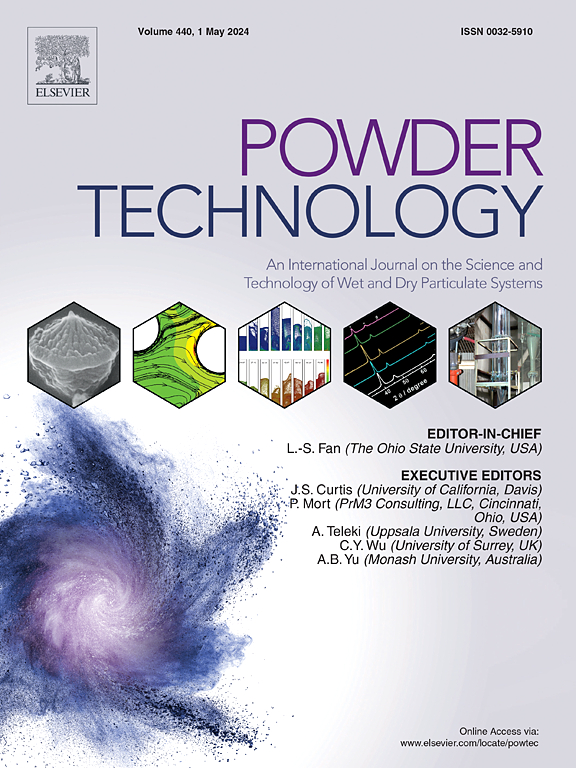Granular flow in screw conveyors: A review of experiments and discrete element method (DEM) studies
IF 4.5
2区 工程技术
Q2 ENGINEERING, CHEMICAL
引用次数: 0
Abstract
Screw conveyors are essential in industries such as mineral processing, agriculture, chemicals, plastics, cement, and food processing, facilitating granular material transport and mixing. Despite their mechanical simplicity, the complex physics of granular flow poses challenges, including bridging, blockages, and inefficient mixing. This review examines transport mechanisms and mixing in screw conveyors through experimental studies and Discrete Element Method (DEM) simulations. DEM enables detailed analysis of particle interactions, capturing transport dynamics based on Newton's laws of motion. Key operational parameters—rotational speed, inclination angle, and fill level—significantly impact transport efficiency and mixing behaviour. Recent advancements in DEM, including integration with Computational Fluid Dynamics and Finite Element Analysis, have improved predictive accuracy and system optimization. These combined approaches enhance the modelling of fluid-solid interactions and mechanical stresses. Future research aims to refine particle models by integrating complex behaviours, including cohesion, breakage, and shape variations. The efficiency of simulations is expected to be further enhanced through high-performance computing and emerging technologies such as quantum computing, thereby reducing computational costs. Implementing of real-time data analytics and predictive maintenance is anticipated to facilitate adaptive system control, ensuring stable and efficient operation. Cross-disciplinary collaboration is crucial for refining validation techniques and improving software accessibility, aligning DEM simulations with experimental and industrial applications. An integrated approach to studying granular flow in screw conveyors bridges theoretical and practical insights, enhancing efficiency, reliability, and the broader applicability of DEM in optimizing screw conveyor performance across industries.

螺旋输送机中的颗粒流:实验与离散元法研究综述
螺旋输送机是必不可少的行业,如矿物加工,农业,化工,塑料,水泥,食品加工,促进颗粒物料运输和混合。尽管它们的力学简单,但颗粒流的复杂物理特性带来了挑战,包括桥接、堵塞和低效混合。本文通过实验研究和离散元法(DEM)模拟研究了螺旋输送机的输送机制和混合。DEM能够详细分析粒子相互作用,根据牛顿运动定律捕获传输动力学。关键的操作参数——转速、倾角和充填水平——对输送效率和混合行为有显著影响。DEM的最新进展,包括与计算流体动力学和有限元分析的集成,提高了预测精度和系统优化。这些综合方法增强了流固相互作用和机械应力的建模。未来的研究目标是通过整合复杂的行为来完善粒子模型,包括内聚、断裂和形状变化。通过高性能计算和量子计算等新兴技术,模拟效率有望进一步提高,从而降低计算成本。实施实时数据分析和预测性维护有望促进自适应系统控制,确保稳定高效运行。跨学科合作对于完善验证技术、提高软件可访问性、将DEM模拟与实验和工业应用结合起来至关重要。一种研究螺旋输送机颗粒流的综合方法将理论与实践相结合,提高了效率、可靠性,并在优化各行业螺旋输送机性能方面具有更广泛的适用性。
本文章由计算机程序翻译,如有差异,请以英文原文为准。
求助全文
约1分钟内获得全文
求助全文
来源期刊

Powder Technology
工程技术-工程:化工
CiteScore
9.90
自引率
15.40%
发文量
1047
审稿时长
46 days
期刊介绍:
Powder Technology is an International Journal on the Science and Technology of Wet and Dry Particulate Systems. Powder Technology publishes papers on all aspects of the formation of particles and their characterisation and on the study of systems containing particulate solids. No limitation is imposed on the size of the particles, which may range from nanometre scale, as in pigments or aerosols, to that of mined or quarried materials. The following list of topics is not intended to be comprehensive, but rather to indicate typical subjects which fall within the scope of the journal's interests:
Formation and synthesis of particles by precipitation and other methods.
Modification of particles by agglomeration, coating, comminution and attrition.
Characterisation of the size, shape, surface area, pore structure and strength of particles and agglomerates (including the origins and effects of inter particle forces).
Packing, failure, flow and permeability of assemblies of particles.
Particle-particle interactions and suspension rheology.
Handling and processing operations such as slurry flow, fluidization, pneumatic conveying.
Interactions between particles and their environment, including delivery of particulate products to the body.
Applications of particle technology in production of pharmaceuticals, chemicals, foods, pigments, structural, and functional materials and in environmental and energy related matters.
For materials-oriented contributions we are looking for articles revealing the effect of particle/powder characteristics (size, morphology and composition, in that order) on material performance or functionality and, ideally, comparison to any industrial standard.
 求助内容:
求助内容: 应助结果提醒方式:
应助结果提醒方式:


